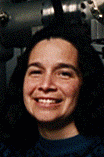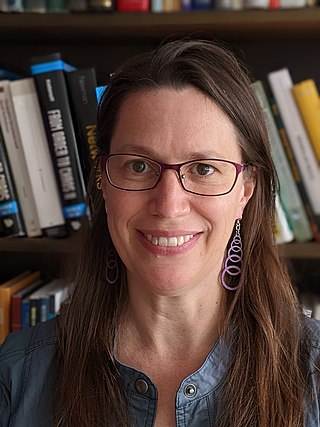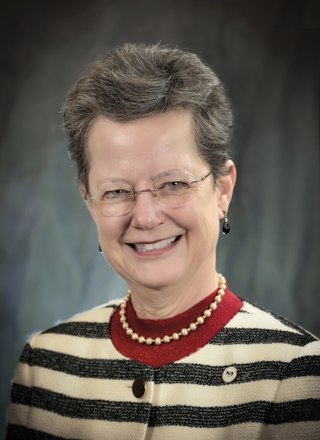Related Research Articles

Maria C. Tamargo is a leading Cuban-American scientist in compound semiconductors and materials science. She is a professor of chemistry at The City College of New York.

Chris G. Van de Walle is a Professor in the Materials Department at the University of California, Santa Barbara. He received a Ph.D. in Electrical Engineering from Stanford University in 1986. Prior to joining UCSB in 2004, he was a Principal Scientist at the Xerox Palo Alto Research Center (PARC). His research interests include first-principles calculations for materials, defects and doping in semiconductors and oxides, surfaces and interfaces, and the physics of hydrogen in materials. Van de Walle is a Fellow of the APS, MRS, AAAS, AVS, and IEEE. He is the recipient of a Humboldt Research Award for Senior US Scientist, the Medard W. Welch Award, and the David Adler Lectureship Award in the Field of Materials Physics from the APS.
Shun Lien Chuang was a Taiwanese-American electrical engineer, optical engineer, and physicist. He was a Fellow of the IEEE, OSA, APS and JSPS, and professor at the University of Illinois at Urbana-Champaign.
Nadya Mason is the Rosalyn Sussman Yalow Professor of Physics at the University of Illinois at Urbana-Champaign. As a condensed matter experimentalist, she works on the quantum limits of low-dimensional systems. Mason is the Director of the Illinois Materials Research Science and Engineering Center (I-MRSEC) and, since September 2022, the Director of the Beckman Institute for Advanced Science and Technology. She is the first woman and woman of color to work as the director at the institute. In 2021, she was elected to the National Academy of Sciences.
Claudia Draxl is a physicist. She is a full professor at the Humboldt University of Berlin in theoretical condensed-matter physics.
Yuri Suzuki is a Professor of Applied Physics at Stanford University. She studies novel ground states and magnetic phenomena. She is a Fellow of the American Physical Society and an American Competitiveness and Innovation Fellow of the National Science Foundation.

Karen E. Daniels is an American physicist who is a professor of physics at North Carolina State University. Her research considers the deformation and failure of materials. She is a Fellow of the American Physical Society, and serves on their Committee on the Status of Women in Physics. She is also a Fellow of the American Association for the Advancement of Science.

Hui Cao (曹蕙) is a Chinese American physicist who is the professor of applied physics, a professor of physics and a professor of electrical engineering at Yale University. Her research interests are mesoscopic physics, complex photonic materials and devices, with a focus on non-conventional lasers and their unique applications. She is an elected member of the US National Academy of Sciences and of the American Academy of Arts and Sciences.
Maria Victoria (Marivi) Fernández-Serra is a Spanish condensed matter physicist known for her research applying density functional theory to the structure and dynamics of water. Other topics in her research include supercomputer simulations of the quantum-mechanical behavior of liquid-metal interfaces, the design of semiconductor-based nanowires, and the development of sensors for detecting dark matter. She is a professor of physics and astronomy at Stony Brook University.
Catherine Kallin is a Canadian theoretical quantum condensed matter physicist whose research topics have included spin wave theory, the quantum Hall effect, frustrated antiferromagnets, chirality in superconductors, and high-temperature superconductivity. She is a professor emerita of physics and astronomy at McMaster University.

Prineha Narang is an American physicist and computational material scientist. She is a Professor of Physical Sciences and Howard Reiss Chair at the University of California, Los Angeles (UCLA). Narang currently serves as a U.S. Science Envoy approved by the Secretary of State to identify opportunities for science and technology cooperation. Before moving to UCLA, she was first an Environmental Fellow at Harvard University Center for the Environment and then an Assistant Professor in the John A. Paulson School of Engineering and Applied Sciences at Harvard University. Narang’s work has been recognized internationally by many awards and a variety of special designations, including the Mildred Dresselhaus Prize, the 2021 IUPAP Young Scientist Prize in Computational Physics, a Friedrich Wilhelm Bessel Research Award from the Alexander von Humboldt Foundation, and a Max Planck Sabbatical Award from the Max Planck Society. Narang also received a National Science Foundation CAREER Award in 2020, was named a Moore Inventor Fellow by the Gordon and Betty Moore Foundation for the development for a fundamentally new strategy for single molecule sensing and environmental toxin metrology using picoscale quantum sensors, CIFAR Azrieli Global Scholar by the Canadian Institute for Advanced Research, and a Top Innovator by MIT Tech Review. Narang was awarded a Guggenheim Fellowship in 2023.
Karen Irene Winey is an American materials scientist and chair of the University of Pennsylvania department of materials science and engineering.
Lillian Christie McDermott was an American physicist. In the early 1970s, McDermott established the Physics Education Group (PEG) at the University of Washington to "improve the teaching and learning of physics from kindergarten all the way through graduate school." She was recognized for her many contributions to the field of physics education research with an election to the American Physical Society in 1990.
Katherine E. Aidala is an American physicist. She is a professor of physics at Mount Holyoke College and a Fellow of the American Physical Society.

Julia Mae Phillips is an American physicist. She began her career in materials research on thin films on semiconductors and has transitioned into leadership roles in science policy. She currently serves on the National Science Board.
Rachel Goldman is an American scientist. She is professor of materials science and engineering, electrical engineering and computer science, and physics at the University of Michigan where she has been a faculty member since 1997. She also serves as the associate director of applied physics at the University of Michigan since 2010.
Nancy Haegel is an American electrical engineer, materials scientist, and solar power researcher, known for her work on semiconductors and large-scale photovoltaic energy systems. Other topics in her research include imaging electronic processes and detecting nuclear radiation. Formerly a distinguished professor of physics at the Naval Postgraduate School, she is the director of the Materials Science Center in the National Renewable Energy Laboratory, and a director of the Research Corporation.
Laurie Elizabeth McNeil is an American condensed matter physicist and materials scientist whose research topics have included optical spectroscopy, the properties of crystals and semiconductors, and the synthesis of carbon nanotubes. She is Bernard Gray Distinguished Professor of Physics and Astronomy at the University of North Carolina at Chapel Hill.
Frieda Axelrod Stahl was an American historian of physics and physics educator known for her work on the language of physics and for her advocacy of women in science. She was a professor emerita at California State University, Los Angeles.
Michael Duryea Williams is an American physicist, professor at Clark Atlanta University, and current president of the AVS: Science and Technology of Materials, Interfaces, and Processing. He is the first African American president of AVS.
References
- 1 2 3 Chambers, Scott (1994-10-01). "Interview: Marjorie Olmstead". avs.org. Retrieved 2021-04-19.
- 1 2 "Dr. Marjorie Olmsted". avs.org. 1994. Retrieved 2021-04-19.
- 1 2 3 4 "Prize Recipient". www.aps.org. Retrieved 2021-04-19.
- 1 2 3 4 "Marjorie Olmstead | Department of Physics | University of Washington". phys.washington.edu. Retrieved 2021-04-19.
- ↑ Mursch, Monica (2020-01-09). "What happens when another STEM major joins the capacity-constrained rankings". The Daily of the University of Washington. Retrieved 2021-04-19.
- 1 2 "Olmstead CV". faculty.washington.edu. Retrieved 2021-04-19.
- ↑ "Past Chairs". aps.org. Retrieved 2021-04-19.
- ↑ "APS Fellow Archive". www.aps.org. Retrieved 2021-04-19.
- ↑ "Prof. Dr. Marjorie Ann Olmstead". www.humboldt-foundation.de. Retrieved 2021-04-19.
- ↑ "Fellow of the Society". avs.org. Retrieved 2021-04-19.
- ↑ "Peter Mark Memorial Award". avs.org. Retrieved 2021-04-19.
- ↑ "NSF91150 - America's Academic Future". nsf.gov. 1992-01-01. Retrieved 2021-04-19.